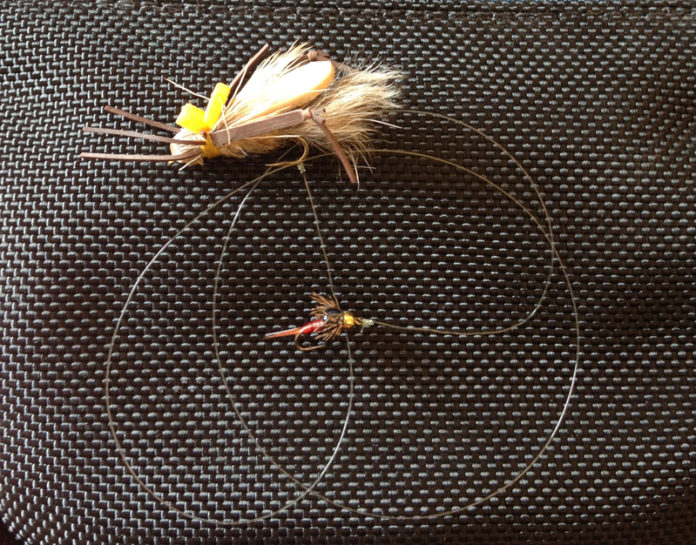The classic “hopper-dropper” is a summertime staple, but there are lots more options.
Photo by Phil Monahan
For the vast majority of anglers, the basic fly-fishing rig is very simple: they tie a single fly to the end of a tapered leader and start casting. And this method obviously works fine, most of the time. But what if I told you that you could increase your catch rate in many situations by fishing two flies instead of one? Further, what if I added that creating such a “tandem rig” much simpler than you imagine?
Multi-fly rigs have been around for hundreds of years—in fact, British fishermen in the late 1800s were known to use “ladders” or “straps” of up to ten flies at once—but the practice gradually fell out of favor in this country, probably because simplicity is an American virtue. Building a special leader that features a “dropper” line from the tag end of a blood knot always seemd pretty fussy to me. But then one day I saw a Montana guide simply knot the dropper to the bend of the top fly, and I mentally slapped myself for not having thought of such a simple solution on my own.
True, tying an improved clinch knot to the bend of a hook isn’t as easy as tying one at the eye, but one simple trick can make all the difference. The loop at the bottom of the clinch knot tends to slide off the hook just as you try to thread the tag end through, but you can solve this problem by simply holding the top fly upside down (hook up). The length of the dropper line should be determined by the water depth and speed, but 18- to 24 inches is a good place to start. If you still struggle with creating tandem rigs on the water, you can tie the two flies together at home and carry the complete rigs in leader envelopes. Then all you’ve got to do is tie on the top fly, and you’re in business.
Useful Fishing Combinations
Once you’ve mastered tying the in-line dropper rig, your options are wide open. Here are just some of the common situations and strategies in which two flies work better than one.
Two Dry Flies: If you know exactly which flies the fish are hitting, you can simply tie on two of the same pattern, thus doubling your chances of a strike. The two-fly rig also helps when you’re trying to figure out which pattern is working best, since you can test-cast twice as many patterns with a tandem rig.
When fish are feeding on tiny flies, it can be difficult to see your minuscule imitation on the water. In such situations, tie on a big, bushy fly, and then add the smaller fly on a 24-inch dropper. That way, the larger fly serves as a locator and a strike indicator—when a fish hits the size 22 fly, the bigger size 10 fly will disappear, too.
Dry Fly and a Nymph: When you have no idea what the fish are eating and you want to cover a lot of water, use a large attractor-pattern dry fly, paired with a generalist nymph—such as a Bead-Head Hare’s Ear Nymph or a Prince Nymph—as a dropper. The theory behind this rig is that you’re going to present each fish with two options. The dry fly also acts as a strike-indicator for the nymph, and the beauty of this system is that it allows you to fish the nymph at a very specific depth. The most popular version of this combo is the “hopper-dropper,” in which the nymph is attached to a high-floating grasshopper imitation—a rig that’s tough to beat on a late-summer afternoon.
Two Nymphs: The double-nymph rig is based on the same theory as the double-dry, and it also helps you to control the depth of the flies. If you know that the fish want something diminutive, such as a size 18 Pheasant Tail, right on the bottom, instead of loading up the line with split-shot, drop the Pheasant Tail from a heavily-weighted fly. This rig much easier to cast than the split-shot, and there’s always the chance that some lunker will find your larger offering attractive.
Two Streamers: In the fall, when trout are trying to fatten up for the long winter, they become more predatory. This is when throwing two streamers can draw savage strikes. Use 24 inches of heavy tippet, 0X or 1X, between the flies to avoid break-offs.
A Streamer and a Nymph: This is the least common tandem rig, but it works well in still water. The larger fly often gets the fish interested, and when the nymph comes swimming by, it’s just too hard to resist. An Olive Woolly Bugger, with an olive, jointed damselfly imitation is a killer combo.
If you’ve never tried fishing a tandem rig, give it a shot; there’s nothing very complicated about the set up, and it will increase your chances of hooking up. By tying your dropper to the bend of the top fly, you create an in-line system that’s easy to task and is less likely to tangle than a rig involving the tag end of a knot in the leader.
Credit: Source link































